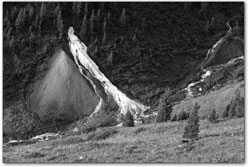|
|
||||
|
Breathing life back into the Animas Stakeholders group tackles four major clean ups SideStory: Beneath the surface of the Animas River
by Shawna Bethell The Animas River Stakeholders Group has already had a busy summer. The coalition dedicated to enhancing water quality in the Animas River watershed has four clean-up projects in progress, and plans for next year’s remediation bids are already in the works. The stakeholders group is an unorthodox coalition that has successfully worked for more than a decade to reverse the impacts of mining and mine waste on the Animas. The group was one of the first of its kind in the country, combining voluntary public and private interests. As a result, the group has helped to motivate federal agencies, pull clean-up funds from Washington, D.C., and undo much of the damage that was inflicted on the Animas River over the past 120 years. Currently, the group has its hands full, and clean up on four mines in the Silverton area is slated to be complete by fall. These mines are on a list of 67 priority waste sites – chosen from a study of 1,500 sites in the region – that the stakeholders group has judged to be the highest-ranking contributors of metals in the Animas River. However, technology, funds and property access are the mitigating factors in deciding which mines are addressed in what order. Infiltration control, which is in progress at the Pride of the West mine, located on the steep slopes of Cunningham Gulch northeast of Silverton, represents one of the more technological and skill intensive projects the group has worked on. Currently, two streams run into two open stopes – the hollow spaces left in the mountain after the ore is removed – left by the Pride of the West mine. The streams rush over 700 vertical feet of mine waste, where they take on pollutants and carry them into the waterways of Cunningham Gulch. In this type of control work, steel beams are set into the stope and topped off with steel plates, closing the stopes and allowing the streams to redivert into their natural channels. At the Pride of the West it will take 180,000 pounds of steel flown in by helicopter to complete the project. The work of the group is ever overwhelming, considering the amount of time and money each project requires. Furthermore, the group is always looking down the road to more projects that need attention. “It is today,” says Bill Simon, coordinator of the Animas River Stakeholders Group, who manages each of the projects. “But you know it is a long-term commitment, and you anticipate what you’re up against, so you are patient.”
Simon explains the Pride of the West project is especially taxing, with weather and the remote and extreme elevation (12,000 feet) making it dangerous for crews. But he notes the adverse conditions are worth it, as this work should permanently reduce metal loading from the mine. The other three mines being worked on in the area are up Prospect Gulch, north of Silverton in the Cement Creek Drainage, where surface waste will be consolidated into one waste dump. This waste, in turn, will be treated and buried in a container impervious to water. This is a rare technique in hard-rock mine remediation due to the typical lack of soil depth for burial of the container. While these projects are ongoing, Simon monitors the progress of past remediation sites looking for growth of vegetation and health of aquatic life. Nature is usually willing to take back the sites if she is allowed to, but recently Simon has found that ATV and four-wheel drive vehicles have been entering the sites and damaging the areas. In an effort to take a pro-active stance, Simon gave a slide presentation to the BLM showing the damage caused by the recreational vehicles. There are plans to add natural barriers to the remediation sites to cease access and to add signage to educate the public as to where their travel is restricted and why. “It takes education,” says Simon. “It’s not only the increased recreational pressures on the areas, it is that our state of mind is being ripped apart by the current administration’s disregard for ecological health. It’s taking a toll on people’s consciousness.” Simon’s frustrations are understandable as sites that are showing regrowth of vegetation are muddied with tire tracks and torn green stalks. Often, he believes, people just don’t know they are on a remediation site. Education is the key. Along with the actual remediation work, the Animas River Stakeholders Group is also reintroducing its own “pilot” Good Samaritan legislation that will temporarily amend the Clean Water Act. The legislation provides a reduction in liability to third party groups, such as the Stakeholders, that clean up America’s waterways. This legislation would not distract from the national Good Samaritan provision potentially being sponsored by U.S. Sens. Wayne Allard, R-Colo., and Ken Salazar, D-Colo., that would possibly be introduced as early as late August. Simon is hopeful the group’s pilot bill could be a useful means to gather support for the broader legislative approach.
|



